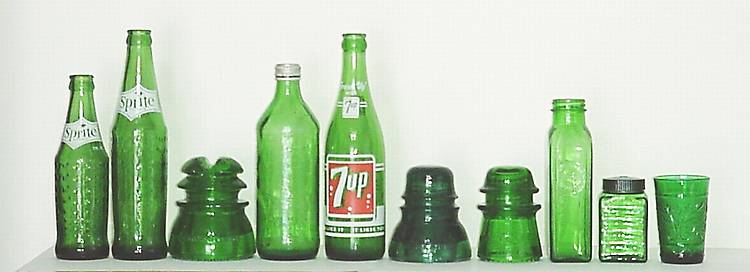Comparison - "7-up" green, emerald green, forest green.
By David Whitten; posted September 19, 2009
View Original: Click to zoom, then click to magnify (1200 x 435) 135KB

|
With the recent questions about shades of green such as "7up" and emerald........I took a pic of a line-up of various glass items in shades of green. My picture shows the colors all quite accurately, EXCEPT viewing in real life, I believe there is just a VERY SLIGHT noticeable teal-blue influence in the "forest green" color of the juice glass on the far right... which doesn't show up in the picture. The Brookfield CD 152 also has a definite darker, teal influence on the color which isn't reproduced quite accurately in the pic. The color of the two insulators in 7-up are SLIGHTLY more brilliant than the bottles....maybe a faint hint of more yellow in the color? Here is a description, from left to right: 1) Sprite bottle, made by Chattanooga Glass Co. in 1970. 2) Sprite bottle, made by Chattanooga Glass Co. in 1961. 3) Hemingray-43 insulator, CD 214, 7-up green, made c.1920s. 4) 7-up bottle, made by Glenshaw Glass Co. in 1970. 5) 7-up bottle, made by Owens-Illinois Glass Co. in 1959. 6) Brookfield CD 152 in (what I perceive as) dark emerald green... c. 1910s. 7) Hemingray-16 (CD 122), 7up green, made in c.1920s. 8) Owens-Illinois-made bottle, (embossed F.H.Pfunder), their typical 7-up green, c.1930s-1940s. 9) Small Owens-Illinois jar (part of a spice, chemical or apothecary set), 7-up green, c.1930s-1940s. 10) Small juice glass in the "Sandwich" pattern, made by Anchor Hocking Glass Co, called "forest green", c.1950s-1960s. |